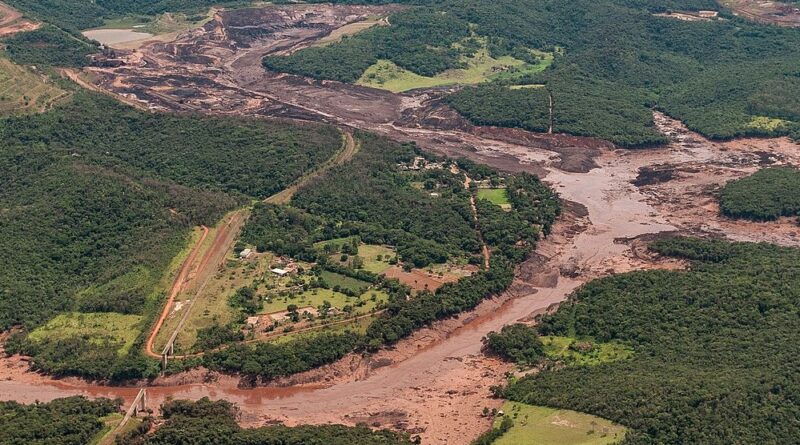Tailings dam disaster: What happened at Brumadinho
The Brumadinho dam disaster occurred on 25 January 2019 when Dam I, a tailings dam at the Córrego do Feijão iron ore mine, 9 kilometres east of Brumadinho, Minas Gerais, Brazil, suffered a catastrophic failure. The dam is owned by Vale, the same company that was involved in the 2015 Mariana dam disaster.
The dam released a mudflow that advanced through the mine’s offices, including a cafeteria during lunchtime, along with houses, farms, inns and roads downstream. 270 people died as a result of the collapse, of whom 259 were officially confirmed dead, in January 2019, and 11 others reported as missing, whose bodies had not been found.
According to the national registry of the National Mining Agency, the Córrego do Feijão dam, built in 1976 by the Ferteco Mineração and acquired by the iron ore miner Vale in 2001, was classified as a small structure with low risk of high potential damage. In a statement, the State Department of Environment and Sustainable Development reported that the venture was duly licensed. In December 2018, Vale obtained a license to reuse waste from the dam (about 11.7 million cubic meters) and to close down activities. The dam had not received tailings since 2014 and, according to the company, underwent bi-weekly field inspections.
Vale SA knew that sensors monitoring the dam’s structural integrity had problems.
THE DAM COLLAPSES
The collapse occurred just after noon. The mud hit the mine’s administrative area, where hundreds of the mine’s employees were having lunch, as well as the “Vila Ferteco”, a small community about 1 kilometre from the mine. At 3:50 p.m., the mud reached the Paraopeba River, the region’s main river, which supplies water to one third of the Greater Belo Horizonte region.
On 27 January, around 5:30 a.m., sirens were sounded amid fears for the stability of the mine’s adjacent Dam VI, a process water reservoir, where increased water levels were detected. Due to the risk, about 24,000 residents from several districts of Brumadinho were evacuated, including the city’s downtown area. Rescue operations were suspended for several hours.
Aftermath
DEAD AND MISSING
On January 26, 2019, Vale’s president, Fabio Schvartsman, stated that most of the victims are Vale’s employees. Three locomotives and 132 wagons were buried and four railwaymen were missing. The mud destroyed two sections of railway bridge and about 100 metres of railway track.
As of January 2020, 259 people were confirmed dead, and 11 were considered missing. Figures were later amended to 270 deaths.
ENVIRONMENTALISTS UP IN ARMS
The dam failure released around 12 million cubic metres of tailings. According to experts, the metals in the tailings will likely be incorporated into the river’s soil and could go on to affect the region’s whole ecosystem. According to environmentalists, the waste stream could also reach the Sao Francisco River, which – in addition to Minas Gerais – passes through four other Brazilian states and the dams of two hydroelectric plants: Retiro Baixo and Tres Marias.
The National Water Agency (ANA) stated that the tailings could pollute over 300 kilometres of river. Vale’s president, Fabio Schvartsman, said that the dam had been inactive since 2015 and that the material should not be moving too much. “I believe that the environmental risk, in this case, will be much lower than that of Mariana”, he said.
ECONOMIC IMPACT
As a result of the disaster, on 28 January the Vale S.A. stock price fell 24%, losing US$19 billion in market capitalization, the biggest single day loss in the history of the Brazilian stock market.
In the city of Brumadinho, many agricultural areas were affected or totally destroyed. The local livestock industry suffered damages, mainly from loss of animals such as cattle and poultry. The local market was also impacted due to the damages, with some stores and establishments remaining closed for a few days.
REACTIONS
The President of Brazil, Jair Bolsonaro, sent three ministers to follow the rescue efforts. The Governor of Minas Gerais, Romeu Zema, announced the formation of a task force to rescue the victims with dozens of firefighters reallocated to Brumadinho.
On January 29, Brazilian authorities issued arrest warrants for five employees believed to be connected with the dam collapse, leading to two senior managers of the mine and another Vale employee being arrested, alongside two engineers from the German company TÜV Süd who had been contracted to inspect the dam.
The local mining union’s treasurer called the disaster “premeditated” as there were continuous and long-standing complaints and warnings about the structural integrity of the dam. Vale denied these charges and stated the mine was up-to-date with the latest standards.
One day after the failure, the Brazilian Institute of Environment and Renewable Natural Resources announced a R$250 million fine on the Vale company.
Brazilian judicial authorities froze US$3 billion of Vale’s assets, saying real estate and vehicles would be seized if the company could not come up with the money.
In April, Vale’s safety inspectors refused to guarantee the stability of at least 18 of its dams and dikes in Brazil.
Brazilian prosecutors announced, on January 21, 2020, that Vale SA, auditor TÜV Süd, and 16 individuals would be charged.
A global database of mine tailing storage facilities and associated disclosures was announced by GRID-Arendal through the support of the UN Environmental Program. The database enables users to examine information disclosures on tailings dams by location, company, dam type, height, volume, and risk, among other factors.




